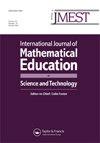Modelling the historic total global human population
IF 0.6
Q3 EDUCATION & EDUCATIONAL RESEARCH
International Journal of Mathematical Education in Science and Technology
Pub Date : 2023-10-31
DOI:10.1080/0020739x.2023.2259388
引用次数: 0
Abstract
AbstractThe historic total global human population dataset is available on Wikipedia and provides an opportunity for modelling with simple models such as the exponential and logistic differential equations for population. Using the per-capita population growth rate (PPGR) predicted by these two models and estimated PPGR from the data, we are able to estimate parameters for the exponential model and discover that we cannot estimate parameters for the logistic model. However, we are able to create a new differential equation that models this data using ideas from the derivation of the logistic model. This is the superexponential model that goes to infinity in finite time. While the initial exponential and superexponential models are good for approximating the population data, neither really matches the PPGRs estimated from the data. We switch to a hybrid model that better matches the estimated PPGRs. It is superexponential for the first portion of the data and logistic for the rest. This hybrid model greatly reduces the modelling error and can extrapolate from the data. We note that the model switches between superexponential and logistic around 1960, the year the FDA-approved oral contraceptives, a fascinating historical tie-in with our modelling.KEYWORDS: Populationper-capita population growth ratelogistic modelexponential modelsuperexponential modelMATHEMATICAL SUBJECT CLASSIFICATIONS: 97M1092-10 Disclosure statementNo potential conflict of interest was reported by the author.模拟历史上的全球人口总数
摘要维基百科上的历史全球人口数据集提供了一个简单模型建模的机会,如人口的指数和逻辑微分方程。利用这两种模型预测的人均人口增长率(PPGR)和从数据中估计的PPGR,我们可以估计指数模型的参数,而发现logistic模型无法估计参数。然而,我们能够创建一个新的微分方程,利用逻辑模型的推导思想对这些数据进行建模。这是在有限时间内趋于无穷的超指数模型。虽然最初的指数和超指数模型可以很好地近似种群数据,但它们都不能真正匹配从数据中估计的ppgr。我们切换到一个混合模型,更好地匹配估计的ppgr。对于数据的第一部分,它是超指数的,对于其余部分,它是逻辑的。该混合模型大大减小了建模误差,并能根据数据进行外推。我们注意到模型在1960年左右在超指数和逻辑之间切换,这一年fda批准了口服避孕药,这与我们的模型有一个迷人的历史联系。关键词:人口人均人口增长率统计学模型指数模型超指数模型数学学科分类:97M1092-10披露声明作者未报告潜在利益冲突。
本文章由计算机程序翻译,如有差异,请以英文原文为准。
求助全文
约1分钟内获得全文
求助全文
来源期刊

International Journal of Mathematical Education in Science and Technology
EDUCATION & EDUCATIONAL RESEARCH-
CiteScore
3.30
自引率
11.10%
发文量
123
期刊介绍:
Mathematics is pervading every study and technique in our modern world, bringing ever more sharply into focus the responsibilities laid upon those whose task it is to teach it. Most prominent among these is the difficulty of presenting an interdisciplinary approach so that one professional group may benefit from the experience of others. The International Journal of Mathematical Education in Science and Technology provides a medium by which a wide range of experience in mathematical education can be presented, assimilated and eventually adapted to everyday needs in schools, colleges, polytechnics, universities, industry and commerce. Contributions will be welcomed from lecturers, teachers and users of mathematics at all levels on the contents of syllabuses and methods of presentation.
 求助内容:
求助内容: 应助结果提醒方式:
应助结果提醒方式:


